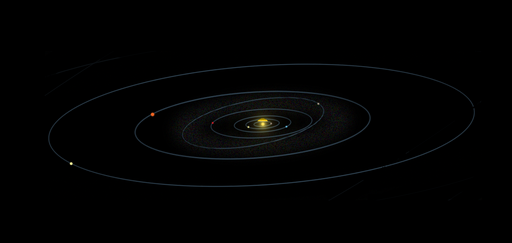Unlocking what happened in our Solar System tens or hundreds of millions of years ago is challenging. For billions of years, millions of objects of different masses interacted as they sought natural stability. As scientists understand the history of our celestial neighborhood, they can better understand what we see today in our Solar System and other distant star systems.

(Photo: Wikimedia Commons/ Andrew Z. Colvin)
Astronomical Migration
The giant planets in our solar system—Jupiter, Saturn, Uranus, and Neptune—used to have more circular and compact orbits at the beginning of the solar system than they do today. Prior studies suggest that orbital instability in our celestial neighborhood altered that orbital configuration and caused smaller planetesimals to be dispersed. Many of these objects collided with the inner terrestrial planets in what experts have called Late Heavy Bombardment.
The timing of the orbital instability is poorly constrained, but it is vital since it determines when some of the familiar features of the Solar System will develop. They may even have affected the habitability of the Earth.
READ ALSO: Jupiter Would Make Earth More Habitable If Gas Giant's Orbit Got Weirder [Study]
Dating Orbital Instability
At the University of Leicester, space scientists have found clues to the shift in the positions of the giant planets in our Solar System, which could also have been key to the formation of our moon. Their findings are described in the paper "Dating the Solar System's Giant Planet Orbital Instability using Enstatite Meteorites."
Led by Dr. Chrysa Avdellidou from the School of Physics and Astronomy, the research team combined evidence from observations, simulations, and meteorite analysis to recreate the orbital instability that caused the giant planets of our solar system to move into their current positions, known as the Nice model.
According to Avdellidou, the question is when this event occurred. It is believed that the orbits of the giant planets destabilized because of some dynamic processes, and then they took their final locations, which we observe today. Each timing has a different implication and has been a significant matter of debate in the scientific community.
What they have tried to do with their study is to not only conduct pure dynamical research but combine several types of studies by linking dynamical simulations, observations, and meteorite studies.
The team focused on a type of meteorite called enstatite chondrites. This space rock has a very similar composition to Earth and very similar isotopic ratios, indicating that they were formed in our solar system. Through spectroscopic observations using ground-based observations, the astronomers linked those meteorites to Athor, a family of fragments in the asteroid belt. Their analysis suggests that Athor was originally much larger and formed closer to the Sun. A collision, however, reduced its size out of the asteroid belt.
To find out how Athor ended up in the asteroid belt, Avdellidou and colleagues tested different scenarios that used dynamic simulations. The research team concluded that gravitational instability was the most likely explanation, which shifted the giant planets to their current orbits. Analysis of these meteorites reveals that this event happened no earlier than 60 million years after the solar system was born.
RELATED ARTICLE: How Did the Planets of Solar System Align on the Same Plane? Orbit Line-Up Explained 4.5 Billions of Years Ago
Check out more news and information on Orbit in Science Times.










!['Cosmic Glitch' in Einstein's Theory of General Relativity Could Be Explained in This New Scientific Tweak [Study]](https://1721181113.rsc.cdn77.org/data/thumbs/full/53435/258/146/50/40/cosmic-glitch-in-einsteins-theory-of-general-relativity-could-be-explained-in-this-new-scientific-tweak-study.jpeg)



